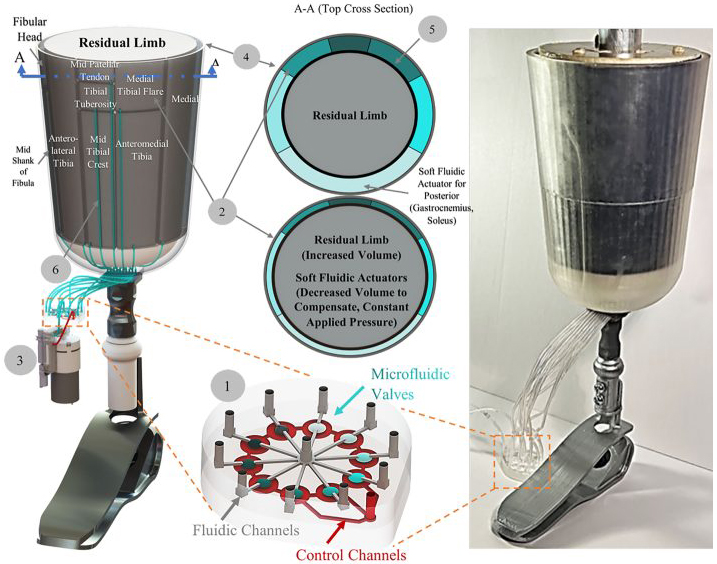At the University of Waterloo in Canada, researchers have developed a microfluidic-based pneumatic system that adjusts the pressure within the socket of a lower limb prosthesis. The aim is to achieve the ideal pressure and adjust the fit of the prosthesis to compensate for changes in the size of the residual limb because of swelling. Current lower limb prostheses require users to change silicone and fabric liners manually to adjust the fit of their prosthetic device. This is suboptimal, particularly in patients with diabetes who may have limited feeling in their residual limb, leading to chafing and ulceration. This new device contains miniaturized pneumatic actuators that can precisely control the fit of the prosthesis, helping to reduce irritation.
Diabetes is a leading cause of leg amputation and these patients have an additional complication when it comes to managing their residual limb. Diabetes can also result in a loss of sensation in the residual limb, which makes it difficult to know if a prosthesis is causing an issue or not. The interface between a residual limb and a prosthesis can become problematic if a limb swells throughout the day, but patients with diabetic neuropathy may not be aware that chafing and friction is occurring. This may eventually lead to serious issues, such as ulcers.
Swelling in the lower limb can be unpredictable, and current prosthesis wearers manually change silicone and fabric liners to adjust the fit as required. However, in patients with diabetes this technique is not as useful as the limited sensation can mean they are unaware that there is an issue to begin with. This problem prompted the University of Waterloo researchers to develop a new system that can adjust the pressure experienced by the residual limb automatically.
The system consists of miniaturized soft robotic actuators that are controlled by a microfluidic device. The microfluidic component contains ten integrated pneumatic valves that control one actuator each. The actuators line the socket of the prosthesis, and help to adjust the pressure as required. “Rather than creating a new type of prosthetic socket, the typical silicon/fabric limb liner is replaced with a single layer of liner with integrated soft fluidic actuators as an interfacing layer,” said Carolyn Ren, a researcher involved in the study. “These actuators are designed to be inflated to varying pressures based on the anatomy of the residual limb to reduce pain and prevent pressure ulcerations.”
In the future, the Canadian team hopes to refine the system so that it redistributes pressure away from areas of the residual limb that are particularly sensitive to pressure, such as the fibular head, to other areas that are better able to handle pressure. The hope is that the technology will lead to prostheses that are more comfortable to use and less likely to contribute to issues such as ulcers.
Study in journal Biomicrofluidics: Air microfluidics-enabled soft robotic transtibial prosthesis socket liner towards dynamic management of residual limb contact pressure and volume fluctuation
